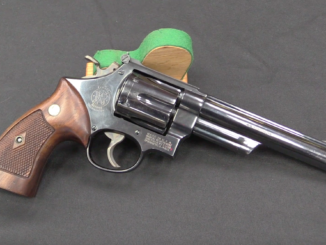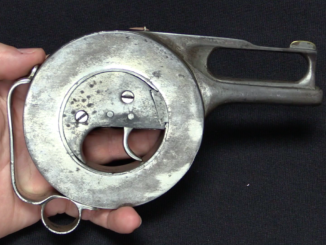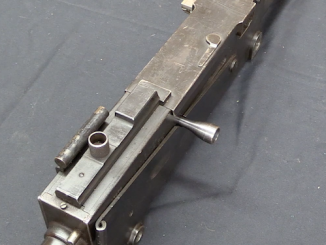This revolver appears to be one of the pre-production prototypes S&W made for the Russian No.3 revolver contract. Its frame has been expertly converted to a birdshead style. It handles very nicely, but was apparently not ultimately desired by the Russian purchasing commission, and the design was not used beyond this prototype sample.
Related Articles

Commentary
Guns in the Movies (Video)
Today we have not so much an examination of a specific firearms, but rather a look at how Clint Eastwood’s film portrayal of Dirty Harry Callahan drove a huge wave of popularity of the Smith […]

Prototype
McCarty’s Peculiar Revolver
William McCarty patented this turret revolver design in 1909 (submitted in 1908, approved in 1909), with the idea of making a high capacity revolver. His gun held 18 rounds of .22 rimfire ammunition – double […]

Medium MGs
The First Browning 1919: The Automatic Tank Machine Gun
This transferrable 1919 tank MG is being sold at Morphys on October 30, 2018. In 1918 the United States began manufacturing tanks for the war effort in Europe, and these tanks naturally required armament. The […]

Looks more like a Bisley grip than a birds head to me.
Exactly. I associate “birds head” to a grip with a rounded butt.
Also licensed to Ludwig Loewe of Berlin for manufacture for Russia. If I read my history right, the humpless backstrap is supposed to aid re-cocking in single action, however the Russians preferred, and ordered, the middle-finger extra (trigger? trigger guard hook?) extension under the trigger guard. Very much a one-handed handgun for cavalrymen. C&Rsenal, as usual, has a very extensive history of the development on their channel.
The “hook” was not for the middle finger. It was where the trigger finger was to be placed when the revolver was in the hand, cocked, when on horseback. The idea being to prevent ADs if the horse bucked, stumbled or etc.
You see the same “hook” on many pairs of dueling pistols. And again, it was where the trigger finger went when waiting for the order to turn and fire.
cheers
eon
The trigger-guard spur could serve the purpose of a ‘safety finger rest,’ I suppose, but it also provided a place to rest the middle finger to give added support for precise aiming a gun intended for one-hand-only use. S&W offered the spurred guard on later models as an option, after the Russian 3rd Model (which had the spur as standard) was replaced by the NM3, particularly on those intended for target shooting, such as the NM3 Target in .32-44 and .38-44, to add in steadying the gun and in recoil recovery. These latter guns were NOT in any sense intended for cavalry use.
On a dueling pistol, using the ‘spur’ as a place to put the trigger finger as a ‘safety’ seems contraindicated, as the time lost moving the finger from the ‘spur’ into the real trigger-guard and onto the trigger could be the difference between living and dying. I suspect that, again, the ‘spur’ is an additional steadying aid and not a ‘safety’ feature.
Not exactly. When Russia, being rather perfidious, balked at paying S&Ws prices for the Russian 3rd Model, and with nobody in Europe or Russia really caring about US patents and other silliness, Russia contracted with Loewe’s to build knock-off, unlicensed revolvers AND tooling for them, abandoning S&W–and as soon as the Tula arsenal was spooled up with Loewe tooling, they cut Loewe’s adrift too and made their own guns–far more than Loewe’s. In fact, Russia never paid for their last contract shipments of guns from S&W, which nearly bankrupted the company.
Although Loewe-built revolvers are not quite up to S&W standards, the Tula-made ones are considered their equal.
The idea, by the way, for the ‘saw-handle’ grip, the ‘spur’ on the backstrap, and the spurred trigger guard was multi-fold–to steady alignment and aim, to prevent the gun rotating in the palm when it recoiled, and to keep the gun relatively stationary in the hand to speed recocking. Short of having a modern two-handed grip, these things worked rather well.
Thanks for these details. I’m going to re-watch the C&Rsenal video.
I would call that a Bisley style grip, rather than a Birdshead.
This, I suppose, would most accurately be a Model #3 Russian 1st Model 2nd Series–it has the notched hammer, large trigger-pin boss, Cyrillic barrel roll, and is almost certainly in .44 Russian. The grip shape isn’t ‘birds head,’ but is an attempt at what S&W folks call the ‘saw handle’ shape that began with the Russian 2nd Model (adding the backstrap ‘spur’) and continued on into the 3rd model, with the general shape still present in even modern S&W revolvers. The ‘in-the-white’ revolver is an actual Russian 2nd Model, including the ‘saw handle’ shape with the backstrap spur.
As the other commenters said:
– I have associated the bird’s head grip with a rounded butt, as we can see it for example on Colt 1877 Thunder and Lightning;
– this grip form reminds me the Colt Bisley’s grip.
By the way: are there exact definitions of the grip forms? I read and heard the English/American gun terms “bird’s head”, “plow handle”, “square butt”, “rounded butt”, “Bisley”, “saw handle”, but I only intuitively understand them.
Bird’s Head: The grip is literally shaped like the head of a bird, with the ‘beak’ represented by the lower forward corner of the grip, which comes to a point, with the backstrap in a smooth curve and rounded profile sweeping forward at the bottom. S&W used it on some of their 1st and 2nd Models, and Colt used it on their 1877 DAs.
Plow Handle/Saw Handle: The grip frame is at right angles to the main frame, is slightly rounded at the bottom, and looks like the back end of a carpenter’s wood saw. Plow handles in America had downturned rear ends so that the hands were up-and-down, easing wrist strain.
Square Butt: Introduced on the earliest revolvers and handguns, the bottom of the grip frame is flat, and generally bell-shaped. Common on S&W swing-out-cylinder revolvers post 1900.
Round Butt: Think of a ‘square butt’ but with the edges of the bell rounded off and the bottom of the grip semi-circular instead of flat. S&W had/has this as an option on many of their revolvers, and it is more common on short-barreled guns as it is more concealable (no pointy edges).
Bisley: A design created by Colt for a series of target pistols based upon the 1873 Model P single action, but with a curved-forward grip shape instead of a ‘square butt’ type–very much like the S&W illustrated, in fact.. There were other changes to the revolver, of course, but this one is what stood out.
And there you are–clear as mud.
Thank you.
Bird’s head: after many yars, at last I know how to imagine a bird’s head into the shape of the grip.
Saw handle – plow handle: I think these are different types.
The saw handle can be seen on for example the Mortimer, Tatham & Egg muzzleloader pistols. Yes, with its projection on the back of the grip and above the thumb and index finger it is really looks like the carpenter’s saw. – I think this projection made it to a saw handle grip.
In my opinion the plow handle grip is a subtype of the square butt grip. It looks like a croissant cut in half. Its arc bends almost 90 deegres.